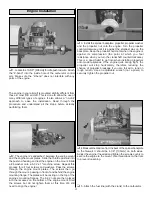
❏
2. Insert the stabilizer into the horizontal stabilizer slot so
it is centered in the fuselage (A). Place the wing onto the
fuselage and secure it with the 1/4-20 x 2" nylon bolts. View
the plane from behind at a distance of about 8 feet [2.4m] to
check the alignment of the stabilizer to the wing (B). If the
stabilizer is not parallel to the wing, remove the stabilizer
and sand the stabilizer base
slightly
on the
high side.
Replace the stabilizer and check the alignment. Continue
this process until the wing and stabilizer are parallel.
❏
3. Attach a piece of string with a T-pin to the center of the
fuselage as shown. Hold the string to one corner of the
horizontal stabilizer. Mark the position on the line, and then
swing the line over to the opposite tip on the stabilizer. If the
mark does not line up, adjust the positioning of the stabilizer
and repeat the “mark and swing” procedure until the
stabilizer is in proper alignment.
❏
4. With the stabilizer properly aligned, use a felt-tip pen to
trace around the tail of the airplane on the top and bottom of
the horizontal stabilizer.
❏
5. Remove the stabilizer and draw two additional lines on
the top and two on the bottom, 1/16" [1.5mm]
inside
the
lines drawn in the previous step. Next, carefully cut through
the covering using a NEW #11 knife blade or soldering iron
at the inside lines and remove the covering from the center
on the top and bottom.
If you are using a hobby knife, do
not cut the wood under the covering! This will seriously
weaken the stabilizer and could easily cause the
stabilizer to break in flight.
If the stab breaks, the plane
has a very good chance of crashing. It is best to be
very
careful when making this cut not to cut into the wood. The
covering must be removed from the center of the stab, or the
bond between the fuselage and stabilizer will be insufficient
and the stab may simply come off in flight.
❏
6. Mix 1/4 oz. [7ml] of 30-minute epoxy. Using a mixing stick,
apply a good layer of epoxy in the stabilizer opening in the
fuselage. Place a thin layer of epoxy on the stabilizer in the
area where the covering was removed. Insert the stabilizer
into the slot from the rear and check the alignment. Wipe off
any epoxy that squeezes out using a paper towel and
rubbing alcohol. Recheck the alignment several times while
the epoxy cures. Allow the epoxy to fully cure before
continuing to the next step.
❏
7. Test fit the fin into the slot in the top of the fuselage. Slide
the fin forward until the leading edge of the rudder is against
the fuselage. Align the hinge on the bottom of the rudder
with the slot in the aft edge of the fuselage. Check the
alignment of the fin with the centerline of the fuselage. A
straightedge against one side of the fin can be used to
check alignment. Make adjustments to the slot if necessary.
❏
8. With the fin properly aligned, use a felt-tip pen to trace
a line along both sides of the bottom of the fin as was done
with the stabilizer. Remove the fin and draw an additional
line 1/16" [1.5mm]
below
the lines drawn in the previous
step. Next, carefully cut through the covering using a new
#11 knife blade or soldering iron at the inside lines and
remove the covering from the center on the top and bottom.
9






































